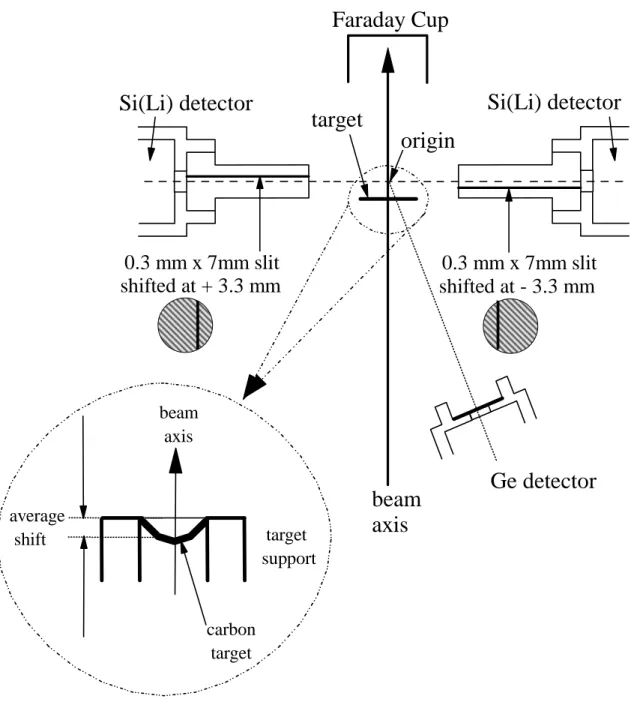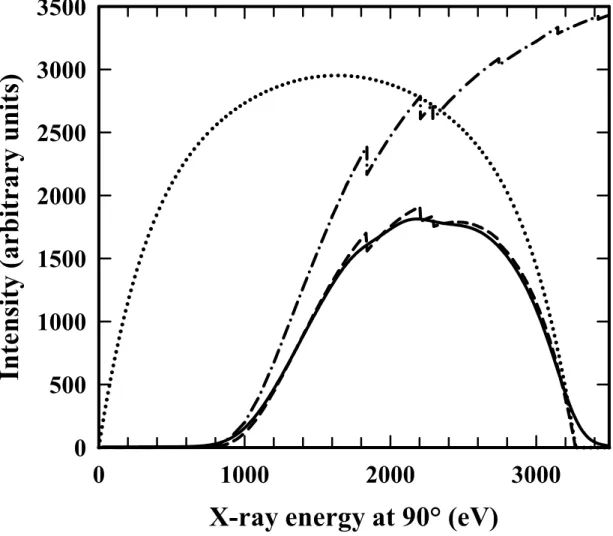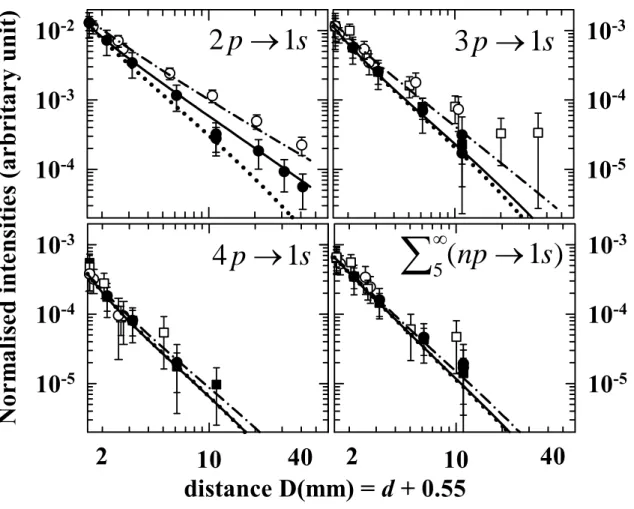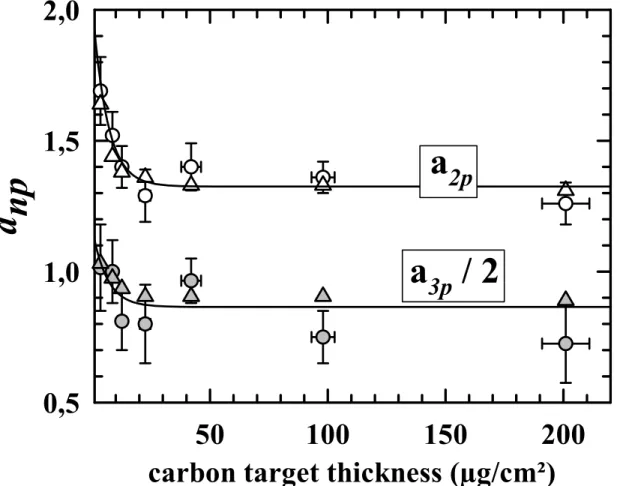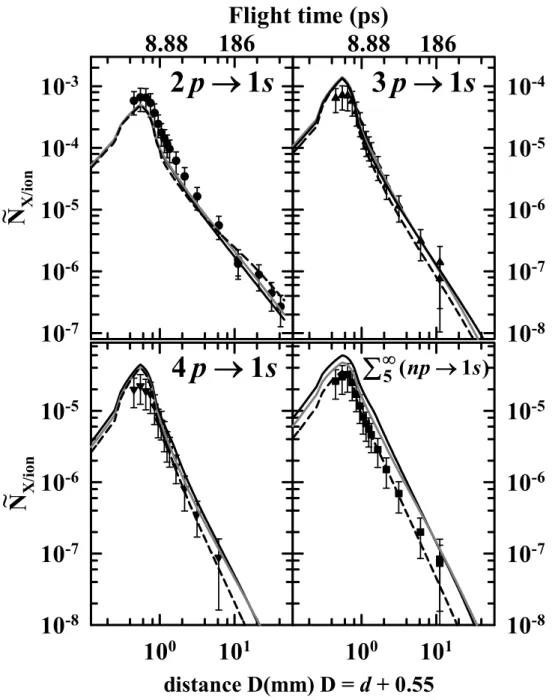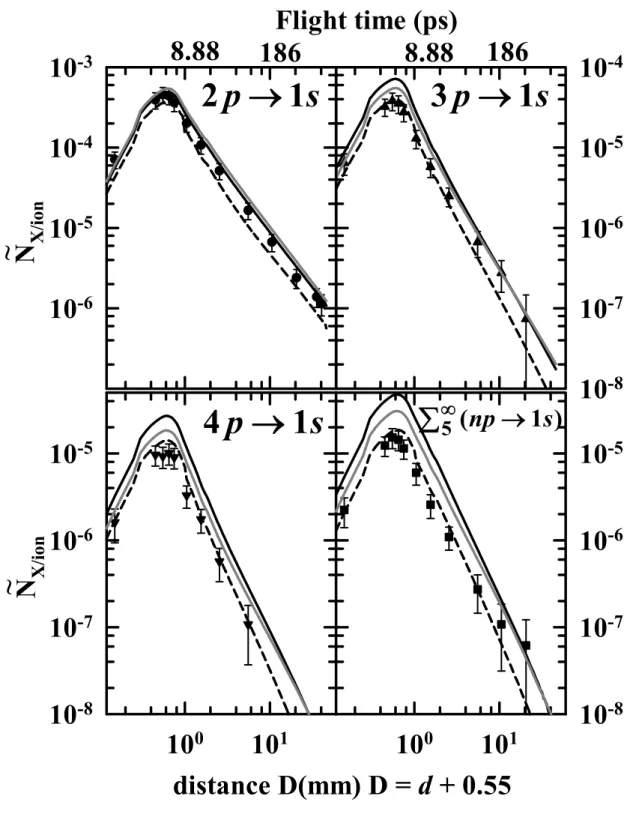HAL Id: hal-00021933
https://hal.archives-ouvertes.fr/hal-00021933
Submitted on 1 Apr 2006HAL is a multi-disciplinary open access archive for the deposit and dissemination of sci-entific research documents, whether they are pub-lished or not. The documents may come from teaching and research institutions in France or abroad, or from public or private research centers.
L’archive ouverte pluridisciplinaire HAL, est destinée au dépôt et à la diffusion de documents scientifiques de niveau recherche, publiés ou non, émanant des établissements d’enseignement et de recherche français ou étrangers, des laboratoires publics ou privés.
Production and transport of long lifetime excited states
in pre-equilibrium ion solid collisions
Emily Lamour, Benoit Gervais, Jean Pierre Rozet, Dominique Vernhet
To cite this version:
Emily Lamour, Benoit Gervais, Jean Pierre Rozet, Dominique Vernhet. Production and transport of long lifetime excited states in pre-equilibrium ion solid collisions. Physical Review A, American Physical Society, 2006, 73, pp.042715. �10.1103/PhysRevA.73.042715�. �hal-00021933�
TABLES
TABLE I. Respective contribution of direct and cascade population to the total population for different nl states and two target thickness. The direct contribution corresponds to the population at the exit of the foil. The cascade contribution corresponds to the population coming from upper levels by radiative decay behind the foil.
3.5 µg/cm2target 98 µg/cm2 target nl state % direct % cascade % direct % cascade
2p 60 40 51 49
2s 74 26 84 16
3p 89 11 86 14
TABLE II. Energy of each observed line with the associated efficiency and global transmission for one of the Si(Li) detector. The efficiency of the other Si(Li) detector corresponds to 70% of the values given here. EProj and ELab correspond respectively
to energies in the projectile and laboratory frames. Energies of the Lyman line are taken from Ref[23]. "*" marks energy of the centre of the theoretical distribution of the 2E1 decay mode Ref [22].
Energy (eV) Si(Li) detector
Observed
Lines EProj ELab
(θL=90°) Efficiency nl glob T Lyα 3321 3273 0.83 (±7%) 8.62 10-6 (±9.5%) Lyβ 3936 3879 0.88 (±7%) 9.20 10-6 (±9.5%) Lyγ 4150 4091 0.90 (±7%) 9.36 10-6 (±9.5%)
∑
∞ → 5(np 1s) 4362 4299 0.91 (±7%) 9.50 10 -6 (±9.5%) 2E1 1660* 1636* 0.39 (±8%) 4.01 10-6 (±10.5%)FIGURES CAPTIONS
FIG. 1. Schematic representation of the experimental set-up. Effects leading to X-ray auto-absorption are displayed in a zoom (see text).
FIG. 2. Energy distribution of the 2E1 decay mode for an Ar17+ ion: the theoretical distribution (dotted line), the distribution corrected by the Si(Li) detector efficiency alone (dashed line) and the "experimental" distribution (solid line) i.e. the distribution corrected by the efficiency convoluted with the detector resolution. Si(Li) detector efficiency is also plotted (dash-dotted line) for sake of clarity.
FIG. 3. Spectra recorded by a Si(Li) detector after backgrounds subtraction at various ion time of flight (delay time) behind the 3.5 µg/cm2 carbon target: (a) t = 0; (b) t = 108 ps; (c) t = 600 ps.
FIG. 4. Normalized evolution of the Lyman lines emission (see text) as a function of the distance behind the target: experimental data (symbols: ● target of 3.5 µg/cm2, ■ 8.6 µg/cm2, □ 98 µg/cm2 and ○ 201 µg/cm2), binary ion-atom conditions i.e. including
cascade contribution without any transport effects accounted for (dotted curves), classical transport "wake off" (solid curves: target of 3.5 µg/cm2, dashed dotted curves: 201 µg/cm2). The real distance d behind the target has been arbitrary shifted by 0.55 mm to clarify the graph.
FIG. 5. Slope evolution of the delayed Lyman line intensities versus foil thickness; circles with error bars: experiment (symbols with error bars); classical transport (triangles); fit with a decay function given in the text (solid lines). The a3p has been
divided by 2 to clarify the graph.
FIG. 6. Evolution with the time of flight of the Ar17+ Lyman line intensities (i.e. number of emitted photon per ion) for the 3.5 µg/cm2 carbon target: experimental results (symbols), classical transport model "wake off" (solid black lines) and "wake on" (solid grey lines), rate equation model (dashed lines). In the simulations, the CDW calculations have been used to account for the primary capture processes. The distance behind the target has been arbitrary shifted by 0.55 mm for sake of clarity.
FIG. 7. Same as Fig. 6 for the 8.6 µg/cm2 target thickness.
FIG. 8. Same as Fig. 6 for the 12.6 µg/cm2 target thickness.
FIG. 9. Same as Fig. 6 for the 42 µg/cm2 target thickness.
FIG. 10. Same as Fig. 6 for the 98 µg/cm2 target thickness.
FIG. 11. Absolute 2s1/2 populations of Ar17+ at vp = 23 a.u. impact velocity as a
conditions i.e. including cascade contribution without any transport effects accounted for (dotted black curve); classical transport model "wake off" (solid black line) and "wake on" (solid grey line); rate equations model (dashed black line); Master equations model with complete CDW calculations to describe the initial capture process (dashed grey line) and Master equations model with CDW calculations and with the phases of coherences of the initial states taken equal to zero (dash-dot-dotted grey line).
FIG. 12. Geometrical efficiency function of Si(Li) detectors for z ≥ 0.87; z is the position of the target support and Z the position where nl → 1s transitions are recorded.
FIG. 13. Geometrical efficiency function of Si(Li) detectors for 0.55 ≤ z ≤ 0.87; z is the position of the target support and Z the position where nl → 1s transitions are recorded. The hatched area is hidden by the support.
FIG. 14. Geometrical efficiency function of Si(Li) detectors for 0.25 + e ≤ z ≤ 0.55; z is the position of the target support and Z the position where nl → 1s transitions are recorded. The parameters e and δ(z) are defined in the text. The hatched area is hidden by the support.
FIG. 15. Geometrical efficiency function of Si(Li) detectors for - 0.07 + e' ≤ z≤ 0.25 +
are recorded. The parameters e, e' and δ(z) are defined in the text. The hatched area is hidden by the support.
FIG. 16. Geometrical efficiency function of Si(Li) detectors for 0.25 ≤ z ≤ 0.87; z is the position of the target support and Z the position where nl → 1s transitions are recorded. The hatched area is hidden by the support.
FIG. 1. Schematic representation of the experimental set-up. Effects leading to X-ray auto-absorption are displayed in a zoom (see text).
Si(Li) detector
Si(Li) detector
Ge detector
target
origin
0.3 mm x 7mm slit
shifted at + 3.3 mm
Faraday Cup
0.3 mm x 7mm slit
shifted at - 3.3 mm
beam
axis
average shift target support carbon target beam axisFIG. 2. Energy distribution of the 2E1 decay mode for an Ar17+ ion: the theoretical distribution (dotted line), the distribution corrected by the Si(Li) detector efficiency alone (dashed line) and the "experimental" distribution (solid line) i.e. the distribution corrected by the efficiency convoluted with the detector resolution. Si(Li) detector efficiency is also plotted (dash-dotted line) for sake of clarity.
X-ray energy at 90° (eV)
0
1000
2000
3000
In
ten
sity
(a
rb
itra
ry
u
n
its)
0
500
1000
1500
2000
2500
3000
3500
FIG. 3. Spectra recorded by a Si(Li) detector after backgrounds subtraction at various ion time of flight (delay time) behind the 3.5 µg/cm2 carbon target: (a) t = 0; (b) t = 108 ps; (c) t = 600 ps.
10
-510
-410
-310
-2N
orm
alized
in
te
n
sit
ies (
arb
it
rary u
n
it
)
10
-710
-610
-510
-4Energy (eV) at 90°
1000
2000
3000
4000
10
-710
-610
-5Ly
α'
Ly
β
Ly
γ
Si-escape peak
Si-escape peak
2E1
Ly
α'=Lyα+M1
Ly
β
Ly
γ
2E1
Ly
α'=Lyα+M1
(a)
(b)
(c)
∑
∞5(np→1s)∑
∞5 (np→1s)FIG. 4. Normalized evolution of the Lyman lines emission (see text) as a function of the distance behind the target: experimental data (symbols: ● target of 3.5 µg/cm2, ■ 8.6 µg/cm2, □ 98 µg/cm2 and ○ 201 µg/cm2), binary ion-atom conditions i.e. including cascade contribution without any transport effects accounted for (dotted curves), classical transport "wake off" (solid curves: target of 3.5 µg/cm2, dashed dotted curves: 201 µg/cm2). The real distance d behind the target has been arbitrary shifted by 0.55 mm to clarify the graph.
10
-410
-310
-210
-510
-410
-3distance D(mm) = d + 0.55
10
10
-510
-410
-3N
orm
alis
ed
int
en
sit
ies
(
arbrit
ary u
n
it
)
10
10
-510
-410
-3∑
∞
→
5
(
np
1
s
)
s
p
1
2
→
3
p
→
1
s
s
p
1
4
→
2
40
2
40
FIG. 5. Slope evolution of the delayed Lyman line intensities versus foil thickness; circles with error bars: experiment (symbols with error bars); classical transport (triangles); fit with a decay function given in the text (solid lines). The a3p has been
divided by 2 to clarify the graph.
carbon target thickness (µg/cm²)
50
100
150
200
a np
0,5
1,0
1,5
2,0
a
2p
a
3p
/ 2
FIG. 6. Evolution with the time of flight of the Ar17+ Lyman line intensities (i.e. number of emitted photon per ion) for the 3.5 µg/cm2 carbon target: experimental results (symbols), classical transport model "wake off" (solid black lines) and "wake on" (solid grey lines), rate equation model (dashed lines). In the simulations, the CDW calculations have been used to account for the primary capture processes. The distance behind the target has been arbitrary shifted by 0.55 mm for sake of clarity.
N
X/i on10
-710
-610
-510
-410
-310
-810
-710
-610
-510
-410
010
1N
X/ion10
-810
-710
-610
-5distance D(mm) D = d + 0.55
10
010
110
-810
-710
-610
-58.88
186
8.88
186
Flight time (ps)
~
~
s
p
1
2
→
s
p
1
4
→
∑
∞5(
np
→
1
s
)
s
p
1
3
→
FIG. 7. Same as Fig. 6 for the 8.6 µg/cm2 target thickness.
N
X/ion10
-610
-510
-410
-310
-210
-710
-610
-510
-410
-3distance D(mm) D = d + 0.55
10
010
1N
X/ io n10
-810
-710
-610
-510
-410
010
110
-810
-710
-610
-510
-4~
~
8.88 186
Flight time (ps)
8.88
186
s
p
1
2
→
s
p
1
4
→
∑
∞5(
np
→
1
s
)
s
p
1
3
→
FIG. 8. Same as Fig. 6 for the 12.6 µg/cm2 target thickness.
10
-810
-710
-610
-510
-410
010
1N
X/i on10
-810
-710
-610
-5distance D(mm) D = d + 0.55
10
010
110
-810
-710
-610
-58.88
186
8.88
186
Flight time (ps)
~
~ N
X/ ion10
-610
-510
-410
-3s
p
1
2
→
s
p
1
4
→
∑
∞
5
(
np
→
1
s
)
s
p
1
3
→
FIG. 9. Same as Fig. 6 for the 42 µg/cm2 target thickness.
10
-710
-610
-510
-410
-3N
X/i on10
-610
-510
-410
-310
-210
010
1N
X/ ion10
-710
-610
-510
-410
-3distance D(mm) D = d + 0.55
10
010
110
-710
-610
-510
-410
-3~
~
8.88
186
8.88
186
Flight time (ps)
s
p
1
2
→
s
p
1
4
→
∑
∞
5
(
np
→
1
s
)
s
p
1
3
→
FIG. 10. Same as Fig. 6 for the 98 µg/cm2 target thickness.
N
X/ io n10
-610
-510
-410
-310
-210
-110
-710
-610
-510
-410
-310
-210
010
1N
X/ ion10
-710
-610
-510
-410
-3distance D(mm) D = d + 0.55
10
010
110
-710
-610
-510
-410
-38.88 186
Flight time (ps)
8.88 186
~
~
s
p
1
2
→
s
p
1
4
→
∑
∞
5
(
np
→
1
s
)
s
p
1
3
→
FIG. 11. Absolute 2s1/2 populations of Ar17+ at vp = 23 a.u. impact velocity as a
function of carbon target thickness: experimental data (symbols); binary ion-atom conditions i.e. including cascade contribution without any transport effects accounted for (dotted black curve); classical transport model "wake off" (solid black line) and "wake on" (solid grey line); rate equations model (dashed black line); Master equations model with complete CDW calculations to describe the initial capture process (dashed grey line) and Master equations model with CDW calculations and with the phases of coherences of the initial states taken equal to zero (dash-dot-dotted grey line).
carbon target thickness (µg/cm²)
1
10
100
2s
1/
2
po
pula
tion/ion
10
-3
10
-2
FIG. 12. Geometrical efficiency function of Si(Li) detectors for z ≥ 0.87; z is the position of the target support and Z the position where nl → 1s transitions are recorded. Z ) (Z g ε beam axis z 0.3 mm 60.4 mm 124.8 mm 0.87 1 target support 0.55 0.25 -0.07
FIG. 13. Geometrical efficiency function of Si(Li) detectors for 0.55 ≤ z ≤ 0.87; z is the position of the target support and Z the position where nl → 1s transitions are recorded. The hatched area is hidden by the support.
Z ) (Z g ε beam axis z 0.3 m m 60.4 mm 124.8 mm 0.87 1 target support 0.55 0.25 -0.07
FIG. 14. Geometrical efficiency function of Si(Li) detectors for 0.25 + e ≤ z ≤ 0.55; z is the position of the target support and Z the position where nl → 1s transitions are recorded. The parameters e and δ(z) are defined in the text. The hatched area is hidden by the support.
Z ) (Z g ε beam axis z 0.3 m m 60.4 mm 124.8 mm 0.87 1 target support 0.55 0.25 -0.07 δ (z)
FIG. 15. Geometrical efficiency function of Si(Li) detectors for - 0.07 + e' ≤ z≤ 0.25 +
e; z is the position of the target support and Z the position where nl → 1s transitions
are recorded. The parameters e, e' and δ(z) are defined in the text. The hatched area is hidden by the support.
Z ) (Z g ε beam axis z 0.3 m m 60.4 mm 124.8 mm 0.87 1 target support 0.55 0.25 -0.07 δ (z)
FIG. 16. Geometrical efficiency function of Si(Li) detectors for 0.25 ≤ z ≤ 0.87; z is
the position of the target support and Z the position where nl → 1s transitions are
recorded. The hatched area is hidden by the support. Z ) (Z g ε beam axis z 0.3 m m 60.4 mm 124.8 mm 0.87 1 target support 0.55 0.25 -0.07 target support


